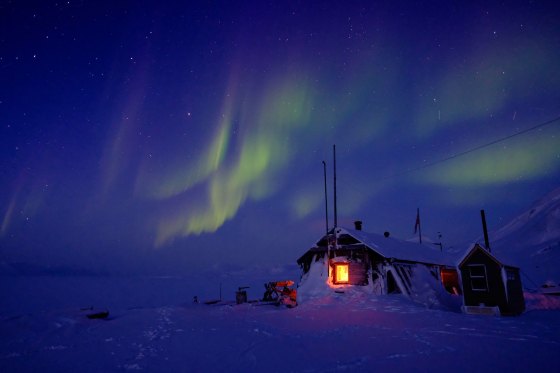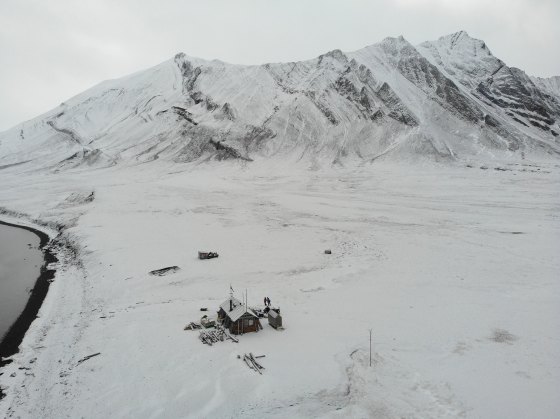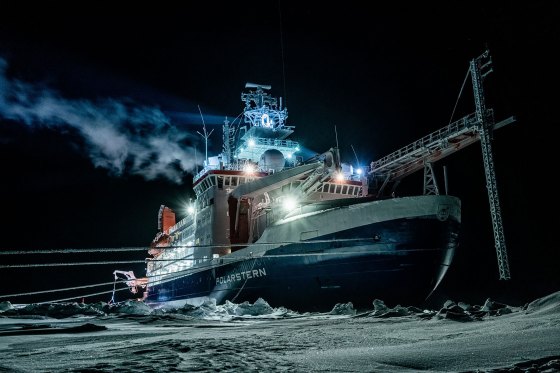[ad_1]
In late 2019, expedition leaders and guides Hilde Falun and Sunniva Sorby traveled to Norway’s distant Svalbard archipelago with a long-term objective of being the primary feminine staff to winter within the Arctic. Nevertheless, the couple’s deliberate return to mainland Norway coincided with the beginning of the COVID-19 pandemic and so they have been stranded fairly rapidly. When the ice started to soften in March, a ship with family and friends was scheduled to come back and choose them up, however journey restrictions stood in the way in which and so they could not get house till September.
As an alternative, they spent the winter and far of the spring by way of Might in an remoted, tiny picket hut excessive up on the Arctic Circle, surrounded by wintry darkness. There was one clear profit, no less than for the worldwide scientific group, nonetheless: simply as the 2 have been caught in Svalbard, fieldwork by local weather scientists and researchers got here to a standstill as those that would usually journey to the Arctic have been involved concerning the content material of melting ice because the area transitions from winter to summer season, caught at house. Given the continued isolation within the Arctic whereas the remainder of the world grappled with a rising pandemic, Falun and Sorby started working with the scientists who couldn’t journey, accumulating knowledge and samples to assist their analysis. Their work proved so helpful that after they lastly acquired house they returned to their little cabin for a second winter in late 2020.
[time-brightcove not-tgx=”true”]
Day by day they ventured into the freezing temperatures, touring on foot or by snowmobile to gather ice, seawater and organism samples to assist scientists perceive the consequences of local weather change in one of many fastest-warming and most fragile components of the world Planets. “They supplied knowledge from a spot the place nobody else was observing,” says Kim Holmén, worldwide director of the Norwegian Polar Institute. “They have been searching for megafauna, seals, polar bears, whales and occasional sightings. These usually are not quantitative knowledge, however they’re actually qualitative knowledge and the inhabitants density could be estimated from such observations. “
Falun and Sorby are technically not scientists. However they’ve seen first hand the adjustments within the Arctic for greater than twenty years within the tourism trade and on expeditions to the far ends of the planet. This was the second winter they spent on Svalbard. Within the winter of 2019-2020, they have been the primary all-women staff to winter within the Arctic; They documented their so-called “Hearts within the Ice” expedition by way of weblog posts, pictures and video chats to boost consciousness of local weather change.

The Arctic is floor zero for rising temperatures, and scientists predict it can heat greater than twice as quick as the general international price within the subsequent 5 years. Within the Svalbard Archipelago, the place Falun and Sorby have been situated, temperatures have risen by three to five ° C for the reason that early 1970s, two to a few occasions greater than the worldwide common. Due to this, and the devastating impression that melting ice might have on the planet as an entire – melting Arctic ice can alter ocean circulation, altering temperature patterns and inflicting excessive climate – it’s so necessary for scientists to watch the area carefully.
Learn extra: “A local weather emergency is unfolding earlier than our eyes.” The Arctic sea ice has shrunk to an virtually historic degree
When the COVID-19 restrictions went into impact, governments and scientists world wide recalled virtually all analysis vessels. Business ships and planes would usually additionally contribute to ocean and climate commentary and knowledge assortment, however with cruise strains not working and business flights being massively lowered because of journey restrictions, there have been fewer assets in every single place. “When it comes to the commentary system as an entire, the primary factor is airborne observations from business plane, they’ve decreased by about 90%,” says Peter Thorne, Professor of Bodily Geography on the Nationwide College of Eire, Maynooth, who additionally holds the Chair in Worldwide Initiative Floor temperature. These observations and knowledge collections are essential to understanding the consequences of local weather change on the planet. “What you do not monitor, you’ll be able to’t perceive at a basic degree,” says Thorne.
In accordance with a current United Nations report, the pandemic has “had a big impression” on land, marine and airborne commentary techniques, creating knowledge gaps that would have an effect on the long-term high quality of forecasting and local weather companies, the report says “Absolutely seen and / and understood”. The gaps that emerged in the course of the pandemic will “develop into increasingly more obvious sooner or later,” says Thorne. That is significantly problematic for our understanding of polar areas and oceans, he explains. “It’s actually the ocean that worries me concerning the lead time required [for monitoring changes] it could not appear apparent concerning the precise time of COVID-19, however we’ll see the impression on the marine commentary system when issues return to regular. ”Within the polar areas, glaciers and permafrost are normally measured annually when the ice thaws and 2021 would be the second yr that scientists can not journey to those components of the world.
The truth is, the pandemic struck proper in the midst of one of many largest collaborative local weather science expeditions ever undertaken: the Multidisciplinary Drifting Observatory for the Examine of Arctic Local weather (MOSAiC), a year-long undertaking that concerned tons of of researchers from 20 international locations who lead it had taken over a decade of planning. With the intention to look at the altering atmosphere within the Arctic intimately, a German analysis ship named Polarstern was intentionally frozen within the ice in October 2019 within the Siberian space of the Arctic; The plan was for researchers from all around the world to take activates board the ship over the course of a yr. 5 months after their icy berth, nonetheless, the Polestern needed to withdraw and sail out of the Arctic as a substitute to succeed in two provide ships in ice-free waters to replenish shares and swap to a brand new group of scientists and alter their crew, which has been on for a number of months Board was. Because the expedition ultimately moved on, there was “an virtually four-week hole within the year-long time collection we collected,” says Madison Smith, a researcher within the Utilized Physics Laboratory on the College of Washington who’s a part of. was the expedition.
A majority of these knowledge gaps aren’t the one impression the pandemic has on local weather science. Local weather negotiations and conferences the place scientists current their work have been canceled and there was little to no alternative to collaborate in individual. One of many best examples of worldwide scientific collaboration is the stories of the Intergovernmental Panel on Local weather Change (IPCC), the UN physique that evaluates science associated to local weather change. Hundreds of scientists and researchers from 195 international locations work collectively on the stories, that are produced each 4 years, and assist inform governments about local weather change measures, reminiscent of setting emission targets. “[The pandemic] have made so many elements of our work troublesome, ”says Thorne, who contributes to the report. The IPCC had anticipated to publish the primary a part of its ultimate report in April 2021, nevertheless it was postponed till August – fortunately in time for COP26, the worldwide UN local weather negotiations that can happen in November.

Throughout their final go to to the Arctic – October 2020 to Might 2021 – considered one of Falun and Sorby’s most troublesome duties was accumulating ice cores, utilizing a particular drill to take away samples a couple of centimeters huge and almost 2.5 toes lengthy from the ice develop into .
Arctic ice sheets entice air bubbles as they type, so these kind of core samples present an summary of previous atmospheric circumstances in addition to a type of biography of microscopic organisms that lived within the space throughout that interval. “We drive our snowmobiles on the ice and take two ice core samples,” says Sorby. “The drill might be as large as we’re and really heavy.” The samples can assist scientists decide how rapidly the ice is melting. “They examined the thickness of the ice and the standard of the ice,” says Holmén. Researchers can use satellite tv for pc imagery to estimate Arctic adjustments, however the samples Falun and Sorby collected give a clearer image of what’s occurring on the bottom.
Throughout their final keep, the duo took on all kinds of different jobs on the ice and within the icy arctic waters. They collected phytoplankton within the ocean for the Scripps Establishment of Oceanography in California. They took samples of salt water and algae for the college middle in Svalbard. Utilizing an infrared drone, they measured the floor temperature of the ocean ice for the British Columbia Institute of Expertise and monitored the wildlife for Holmén and his staff on the Norwegian Polar Institute. In addition they collected bodily proof of human results on the atmosphere. Regardless of their distant location, they consistently discovered and picked up “plastic and numerous marine litter. Nets and all kinds of garbage, you do not consider what’s washed up on land, ”says Sorby.
(Her work has made her stand out in different methods as nicely. A comparatively unknown impact of COVID-19 is what it has wreaked on the careers of ladies scientists, lots of whom are compelled to tackle an inordinate burden of childcare. I fear concerning the careers of ladies scientists with out childcare. At a time when the monitor file of publications is essential. A few of them have been hit actually exhausting, “says Valérie Masson-Delmotte, Co-Chair of the IPCC Working Group I.)

Falun and Sorby hope they’ll share classes from their experiences – which they see as the acute type of isolation that so many individuals world wide have confronted for the previous yr and a half. You’ve gotten realized to dwell extra within the second and recognize small issues, particularly meals, which might develop into scarce. “We have a good time each dinner,” mentioned Sorby in an interview with TIME in February. “Even when we nonetheless have a limp carrot, we’ll have a good time this limp carrot.” They left the Arctic with a message of encouragement to the world to not despair within the face of local weather change, however to take motion. After seeing firsthand the fast adjustments within the Arctic, Sorby desires to empower individuals to make change by turning “local weather desperation” into “local weather engagement and inspiration.”
[ad_2]







































Discussion about this post